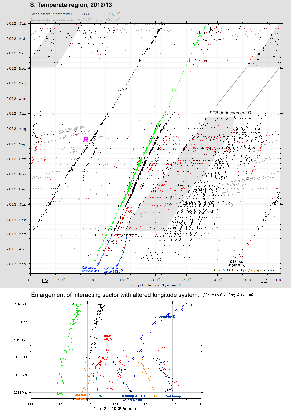

(11) Update on the STB & other
events in the southern hemisphere - May 2013.
Jupiter
in 2012/13: Report no.11, 2013 May 14
Update on the STB & other events in the southern hemisphere
-----------------------------------------------------------
Here
is a brief update on some events in the southern hemisphere, mainly between oval
BA and the GRS, in the light of the latest images and JUPOS charts, some of
which are attached. Congratulations to observers who have continued to get
good images late in the apparition, esp. Chris Go. These charts and images
allow us to follow up the interesting phenomena that we have described in our
posted Report no.10.
1) STB, f. oval BA.
The long dark STB segment (which we call D) is now colliding with oval BA, so we
are very interested to see what happens. Remarkably, in contrast to the
previous such collisions in 2003/04 and 2010, the STB segment has not remained
dark and turbulent, but apparently converted to a chain of cyclonic ovals
associated with a standing wave on the STBs.
Gianluigi Adamoli has measured these features, as shown on the attached chart.
Instead of the usual S.Temperate drift rates of DL2 ~ -11 to -15 deg/month, the
new cyclonic features are moving slowly (DL2 ~ -2 deg/month), and oval BA and
the features f. it have all decelerated as well.
This behaviour is surprising and contrary to my predictions in the last
bulletin! I suspect that the formation of cyclonic cells has caused BA to
decelerate. But they may break up again into a typical microturbulent dark
STB segment, which would then cause BA to accelerate during solar conjunction,
as previously predicted.
2) STB: the new segment E?
Now that STB segment D has encountered oval BA, we expect a new STB structured
segment to develop elsewhere, and we have identified DS4 from last year as the
probable new segment (E). It has changed from a small dark spot in 2011/12 to a
small bright spot surrounded by a pale grey streak, like the early stages of the
previous 'STB Remnant' a few years ago. In a further parallel with the 'STB
Remnant', the JUPOS chart shows that a tiny spot recirculated from the SSTBn
jetstream into the STZ on encountering DS4 (labelled R on the chart), while on
the other side of DS4, new SSTBn jetstream spots are appearing.
3) SPR: a merger of ovals.
The JUPOS chart for lats.57-63 deg.S shows a merger between two anticyclonic
ovals, and some images are included in the attached set 9column A). The
larger oval was slightly reddish, as usual in this latitude. They
apparently merged around March 4-6 but no details can be seen.
4) The new SED.
Although the new SED became ill-defined after passing the GRS on Feb.18, it can
be seen again in Chris Go's images on April 14-23, just after passing the GRS
again. It is on its original track which still appears as a spot-deficient
band on the JUPOS chart (attached). The attached chart also tracks quite a
lot of small dark spots on SEBn, and the usual gradient of speed p. the SED is
clearly still present. So this SED is persisting with all the expected
characteristics.
5) SEB: The dark barge and the light patch.
These two conspicuous spots in the SEB converged in Feb., and the dark barge
disappeared (as a smaller barge had done in a similar encounter earlier), but
the light patch was only temporarily reduced and has since recovered fully
(shown below the blue stars on the images). Its nature is still a mystery.
John
Rogers,
2013
May 14th
John H. Rogers, Ph.D. Jupiter Section Director,
British Astronomical Association
jhr11@cam.ac.uk
http://www.britastro.org/jupiter/